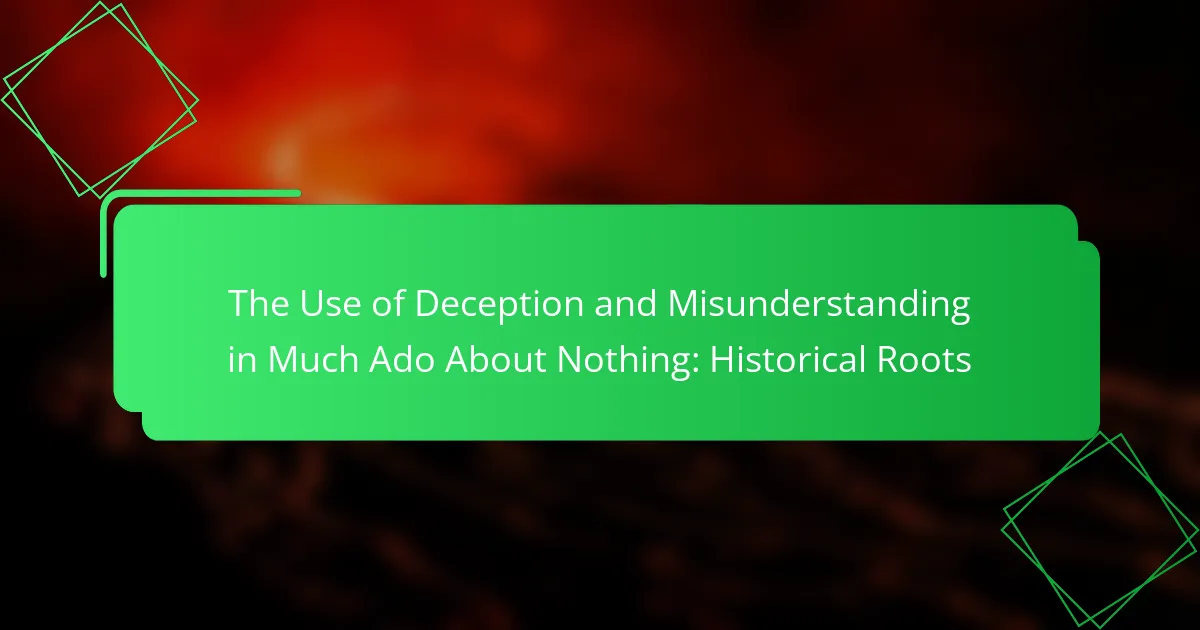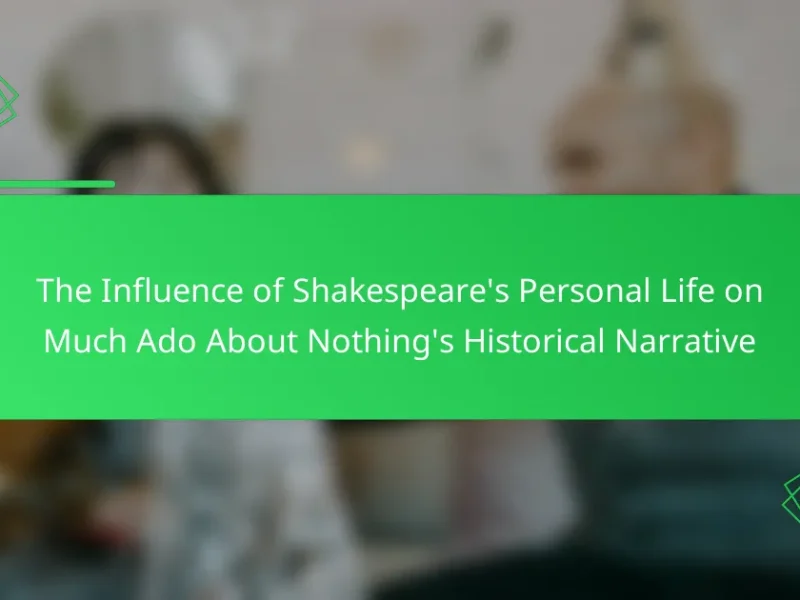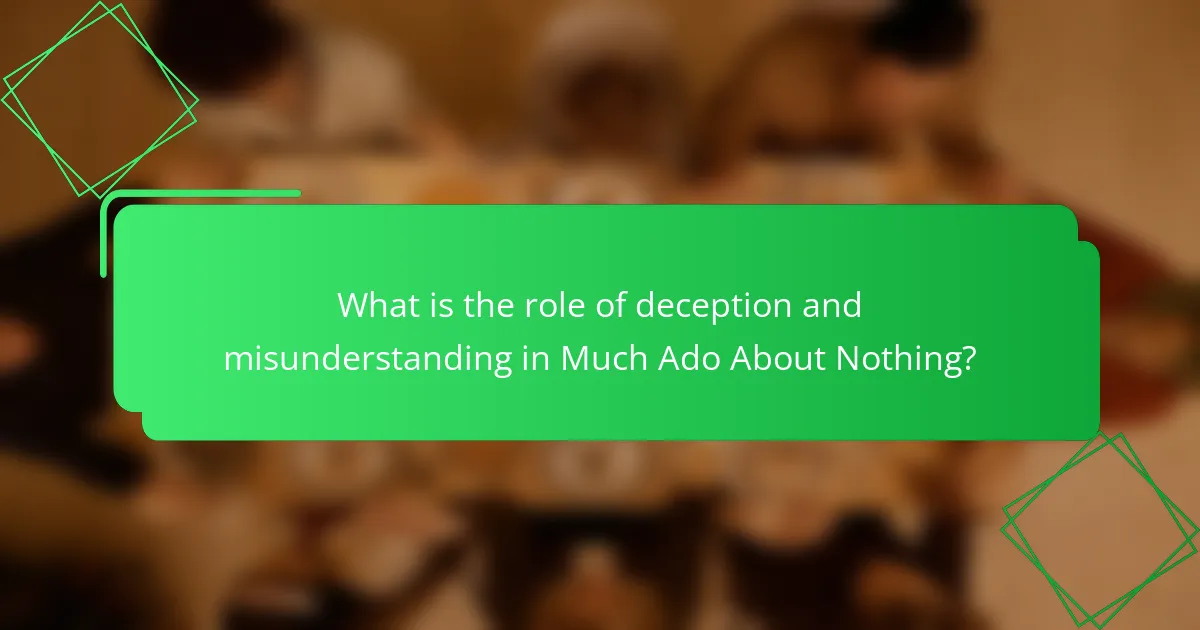
What is the role of deception and misunderstanding in Much Ado About Nothing?
Deception and misunderstanding play crucial roles in “Much Ado About Nothing.” They drive the plot and create conflict among characters. The use of deception leads to mistaken identities and false accusations. For instance, Claudio’s belief that Hero is unfaithful results from a staged misunderstanding. This misunderstanding causes emotional turmoil and challenges relationships. Additionally, the playful deception between Beatrice and Benedick highlights the theme of love. Their witty banter masks their true feelings, illustrating how misunderstandings can lead to romantic connections. Ultimately, deception and misunderstanding reveal character traits and social dynamics. They serve as tools for both conflict and resolution in the narrative.
How does Shakespeare utilize deception in the play?
Shakespeare utilizes deception in “Much Ado About Nothing” through various plots and misunderstandings. The character of Don John orchestrates deception to create discord. He misleads Claudio into believing that Hero has been unfaithful. This deception leads to public humiliation for Hero at their wedding. Additionally, Beatrice and Benedick are tricked into confessing their love through staged conversations. These deceptions drive the narrative forward and highlight themes of trust and betrayal. Shakespeare’s use of deception illustrates the complexities of human relationships and social expectations.
What are the different forms of deception depicted in the play?
The different forms of deception depicted in the play include verbal deception, mistaken identity, and manipulation of perception. Verbal deception occurs when characters use language to mislead others. An example is when Benedick and Beatrice are tricked into believing each other loves them. Mistaken identity plays a crucial role, particularly in the case of Hero and her false accusation of infidelity. Manipulation of perception is evident when Don John orchestrates a scheme to make Claudio doubt Hero’s fidelity. These forms of deception drive the plot and highlight themes of trust and misunderstanding.
How does deception impact character relationships in Much Ado About Nothing?
Deception significantly impacts character relationships in Much Ado About Nothing. The play showcases how misunderstandings and falsehoods create conflict and tension. For instance, Claudio’s belief that he has been wronged by Hero leads to public shaming. This deception strains their relationship and almost results in Hero’s death. Similarly, Beatrice and Benedick’s relationship is tested by their friends’ manipulations. Their friends deceive them into believing the other is in love, which ultimately leads to their union. These examples illustrate how deception drives the plot and shapes character dynamics, revealing the fragility of trust. The consequences of deception highlight the complexity of human relationships in the play.
What historical context influences the themes of deception and misunderstanding?
The historical context influencing the themes of deception and misunderstanding in “Much Ado About Nothing” includes societal norms of the Elizabethan era. During this period, social status and reputation were paramount. Deception often served as a tool for navigating complex social hierarchies. Additionally, the concept of honor was closely tied to personal and familial reputation. Misunderstandings frequently arose from the limited communication methods of the time. The reliance on letters and verbal messages contributed to misinterpretations. Instances of mistaken identity were common in Elizabethan drama, reflecting societal anxieties about trust and loyalty. These elements combined to create a fertile ground for exploring deception and misunderstanding in Shakespeare’s work.
How did the societal norms of Shakespeare’s time shape the portrayal of deception?
Societal norms of Shakespeare’s time significantly influenced the portrayal of deception in his works. The Elizabethan era valued honor, reputation, and social status. Deception often served as a means to navigate these rigid social structures. Characters employed deceit to protect their honor or manipulate social outcomes. For instance, in “Much Ado About Nothing,” misunderstandings arise from societal expectations surrounding marriage and fidelity. The use of masks and disguises reflects the era’s fascination with appearances versus reality. Additionally, gender roles dictated how deception was viewed; women often faced harsher scrutiny for their actions. This context shaped the complexity and moral ambiguity of deceptive acts in Shakespeare’s plays.
What literary influences can be seen in the use of deception in the play?
The use of deception in “Much Ado About Nothing” is influenced by classical literature and contemporary social norms. Classical works, such as those by Plautus and Terence, feature mistaken identities and clever ruses. These elements are echoed in Shakespeare’s play through the character of Don John, who orchestrates deception for malicious intent. Additionally, the social dynamics of the Elizabethan era emphasize honor and reputation, which drive characters to engage in deceit. The interplay of love and misunderstanding reflects the influence of romantic comedies from both ancient and contemporary sources. The resolution of these deceptions ultimately aligns with the comedic tradition, showcasing the transformative power of truth.
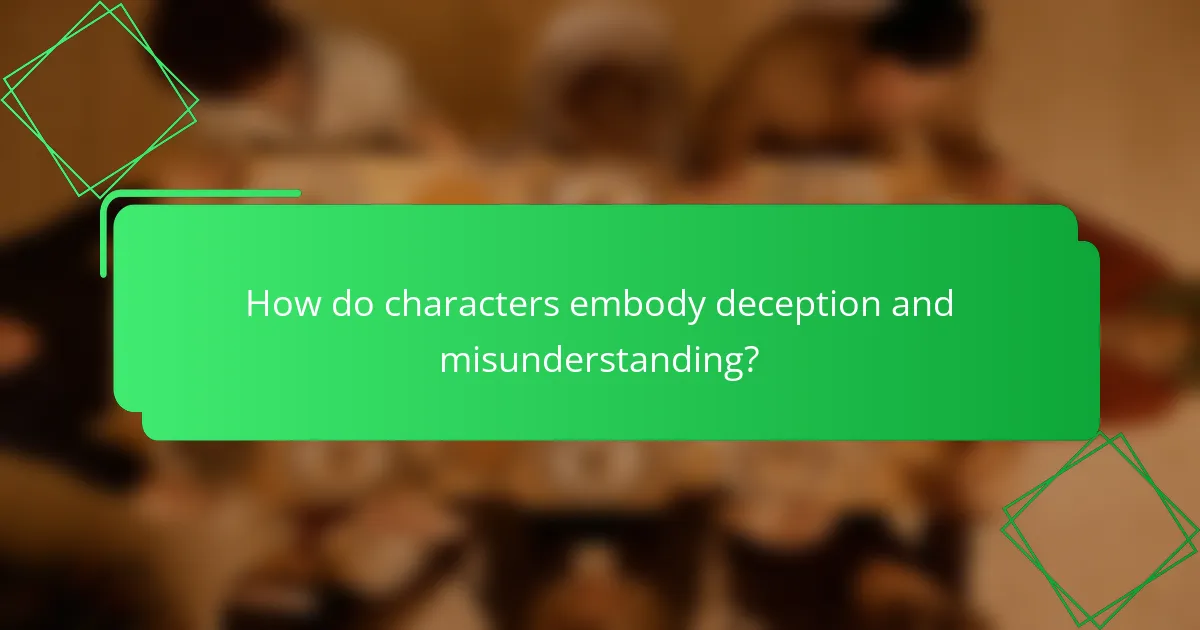
How do characters embody deception and misunderstanding?
Characters in “Much Ado About Nothing” embody deception and misunderstanding through intricate plots and miscommunications. For example, Claudio is misled into believing that Hero is unfaithful. This misunderstanding stems from Don John’s deceptive actions. Similarly, Beatrice and Benedick are tricked into believing the other is in love. This is orchestrated by their friends, who manipulate their perceptions. The characters’ reactions to these deceptions reveal their vulnerabilities. Their misunderstandings drive the plot and highlight themes of trust and betrayal. Ultimately, these elements create dramatic tension and explore the complexities of human relationships.
What are the key characters involved in deception?
The key characters involved in deception in “Much Ado About Nothing” are Don John, Claudio, and Benedick. Don John orchestrates the primary deceptions, driven by jealousy and malice. He deceives Claudio into believing that Hero is unfaithful. Claudio, influenced by Don John’s lies, publicly shames Hero at their wedding. Benedick, initially skeptical of love, is tricked by his friends into believing that Beatrice loves him. These deceptions create conflict and misunderstanding throughout the play. The characters’ actions highlight the themes of trust and betrayal.
How do Benedick and Beatrice’s misunderstandings drive the plot?
Benedick and Beatrice’s misunderstandings are crucial in driving the plot of “Much Ado About Nothing.” Their witty banter and reluctance to admit feelings create tension. The misunderstandings lead to significant plot developments, including schemes devised by other characters. These schemes manipulate both Benedick and Beatrice into believing the other loves them. Their eventual realization of these manipulations propels their relationship forward. This dynamic illustrates the theme of deception in the play. Ultimately, their misunderstandings contribute to the comedic elements and resolution of the story.
What role does Don John play in creating deception?
Don John plays a pivotal role in creating deception in “Much Ado About Nothing.” He is the primary antagonist who orchestrates schemes to disrupt the happiness of others. His motivations stem from a deep-seated resentment towards his brother, Don Pedro, and a desire to cause chaos. Don John manipulates characters like Claudio by falsely claiming that Hero is unfaithful. He uses misinformation to provoke doubt and jealousy. This deception leads to public humiliation for Hero during their wedding. Don John’s actions highlight the destructive power of lies and misunderstandings. His role emphasizes the theme of deception throughout the play.
How do misunderstandings contribute to the play’s comedic elements?
Misunderstandings are central to the comedic elements in Much Ado About Nothing. They create confusion among characters, leading to humorous situations. For example, mistaken identities and misheard conversations drive the plot forward. These misunderstandings often result in characters acting in absurd ways. This absurdity elicits laughter from the audience. Additionally, the misunderstandings reveal the folly of the characters. They highlight the gap between appearance and reality. This theme is common in Shakespearean comedies, enhancing their comedic impact. Overall, misunderstandings serve as a vital mechanism for humor in the play.
What specific scenes highlight the humor in misunderstandings?
Specific scenes that highlight humor in misunderstandings in “Much Ado About Nothing” include the exchange between Beatrice and Benedick. Their witty banter often leads to comical misinterpretations of each other’s feelings. Another scene is when Claudio mistakenly believes that Hero has been unfaithful, leading to a public shaming that is both tragic and humorous. Additionally, the masked ball scene creates confusion as characters do not recognize each other, resulting in humorous interactions. These scenes exemplify how misunderstandings drive the comedic elements of the play.
How do the characters’ reactions to misunderstandings enhance the comedy?
Characters’ reactions to misunderstandings enhance the comedy by creating humorous situations and escalating tension. When characters misinterpret each other’s words or actions, it leads to absurd scenarios. For instance, mistaken identities often result in characters expressing exaggerated emotions. These reactions provoke laughter as audiences witness the absurdity of the situations. The comedic effect intensifies when characters react with frustration or confusion. Their over-the-top responses amplify the humor inherent in the misunderstandings. This technique is prevalent in “Much Ado About Nothing,” where misunderstandings drive the plot. The interplay between characters’ reactions and the resulting chaos creates a rich tapestry of comedy.
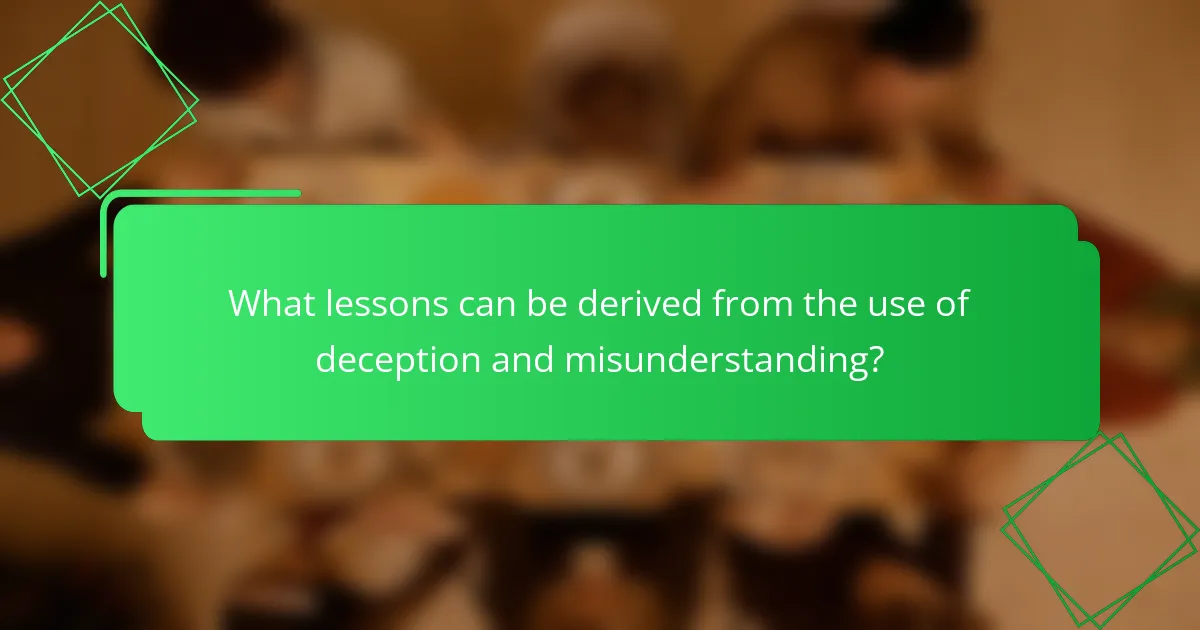
What lessons can be derived from the use of deception and misunderstanding?
Deception and misunderstanding can teach valuable lessons about human nature and relationships. They highlight the fragility of trust among individuals. Miscommunication often leads to conflict and unintended consequences. Historical examples show that deception can manipulate perceptions and alter realities. In “Much Ado About Nothing,” misunderstandings drive the plot and reveal character flaws. These lessons emphasize the importance of clear communication. They also suggest that honesty fosters stronger connections. Ultimately, deception serves as a cautionary tale about the complexities of human interactions.
How can we apply the themes of Much Ado About Nothing to modern contexts?
The themes of Much Ado About Nothing can be applied to modern contexts through the lens of communication and relationships. Misunderstandings often arise in personal and professional settings today, similar to the play’s characters. Deception can manifest in various forms, such as social media misrepresentation or gossip.
The play illustrates how assumptions can lead to conflict, which is relevant in contemporary disputes, both online and offline. Additionally, the resolution of misunderstandings in the play emphasizes the importance of open dialogue and trust.
In modern relationships, addressing issues directly can prevent escalations, mirroring the characters’ eventual reconciliations. Overall, Much Ado About Nothing serves as a reminder of the consequences of miscommunication and the value of honesty in fostering healthy connections.
What parallels exist between the play’s themes and contemporary social interactions?
The play’s themes of deception and misunderstanding parallel contemporary social interactions through the prevalence of misinformation. In both contexts, individuals often misinterpret intentions due to lack of communication. For example, social media amplifies misunderstandings, similar to how characters in the play misjudge one another. Additionally, the desire to manipulate perceptions for personal gain is evident in both the play and modern society. This reflects a timeless human tendency to navigate relationships through deceit. Such parallels illustrate that the dynamics of trust and betrayal remain relevant across eras.
How can understanding deception improve our communication skills?
Understanding deception enhances communication skills by enabling individuals to recognize misleading cues. This recognition allows for more effective interpretation of others’ intentions. Improved interpretation leads to clearer exchanges and reduces misunderstandings. Studies show that awareness of deceptive behavior can improve negotiation outcomes. For example, a 2016 study published in the Journal of Personality and Social Psychology found that individuals trained to detect deception achieved better results in negotiations. This training fosters critical thinking and encourages questioning of ambiguous statements. Overall, understanding deception equips individuals with tools for more honest and effective communication.
What are some key takeaways regarding the historical roots of deception in literature?
Deception in literature has deep historical roots, often reflecting societal norms and values. Ancient texts like Homer’s “The Iliad” showcase deception as a strategic tool in warfare. The use of trickery is prevalent in folklore, illustrating moral lessons or societal critiques. Shakespeare’s works, including “Much Ado About Nothing,” highlight the complexities of human relationships and misunderstandings. These literary examples demonstrate how deception serves both narrative and thematic purposes. Throughout history, deception has been a mechanism for character development and plot advancement. It reveals deeper truths about human nature and societal expectations. Thus, deception in literature is not merely a plot device; it is a reflection of cultural and historical contexts.
How has the portrayal of deception evolved in subsequent literary works?
The portrayal of deception in subsequent literary works has evolved significantly from its early representations. Initially, deception was often depicted as a straightforward moral failing. Characters who engaged in deceit were typically punished or faced dire consequences. Over time, literature began to explore the complexities of deception. Authors started to present deception as a multifaceted tool, used for various purposes, including protection and manipulation.
In the 19th century, works like “The Great Gatsby” illustrated how deception could be tied to the pursuit of the American Dream. This shift highlighted the social implications of deceit. In modern literature, such as in “Gone Girl,” deception is often portrayed as an integral part of identity and agency. Characters use deception to navigate their realities and manipulate perceptions.
This evolution reflects broader societal changes, including attitudes toward truth and morality. Contemporary works frequently blur the lines between truth and falsehood, emphasizing subjective experiences. The portrayal of deception has thus transformed from a clear-cut moral issue to a complex narrative device that invites deeper exploration of human motivations and societal constructs.
What can we learn from Much Ado About Nothing about the nature of truth and deception?
Much Ado About Nothing illustrates that truth and deception are often intertwined. Characters manipulate information to achieve personal goals. For example, Don John deceives others to create chaos and disrupt relationships. This highlights how deception can lead to misunderstandings and conflict. Conversely, the play also shows that truth can emerge from deception. The revelation of Hero’s innocence ultimately restores harmony. Thus, the narrative demonstrates that both truth and deception shape human interactions. The complexities of these themes reflect the multifaceted nature of relationships in society.
The main entity of the article is “deception and misunderstanding” as portrayed in Shakespeare’s “Much Ado About Nothing.” The article examines how these themes drive the plot, create conflict, and shape character relationships, highlighting various forms of deception such as verbal manipulation and mistaken identities. It also explores the historical context of the Elizabethan era, which influenced societal norms regarding honor and reputation, and discusses the comedic elements arising from misunderstandings. Additionally, the article draws parallels between the play’s themes and contemporary social interactions, emphasizing the importance of clear communication and the lessons learned from the complexities of human relationships.
